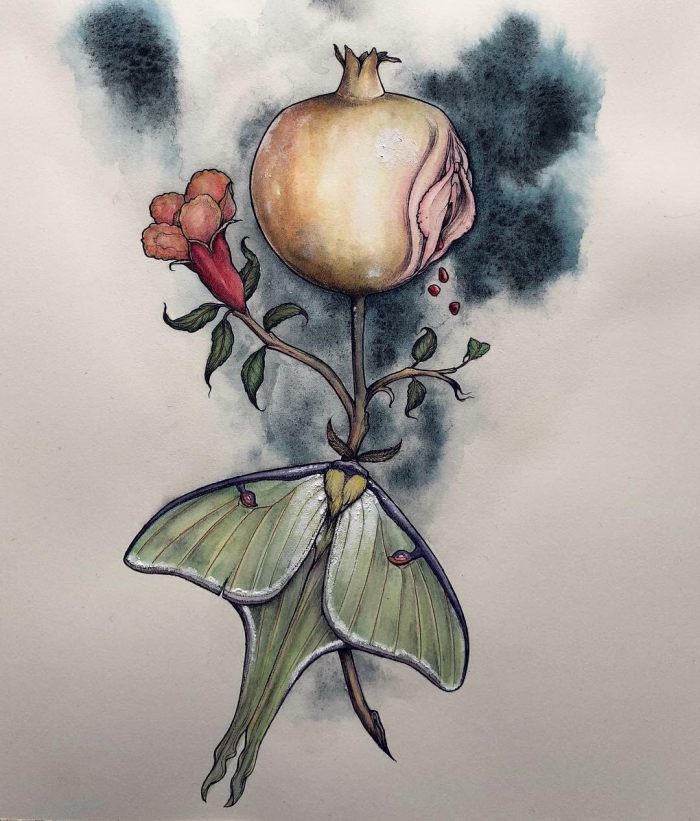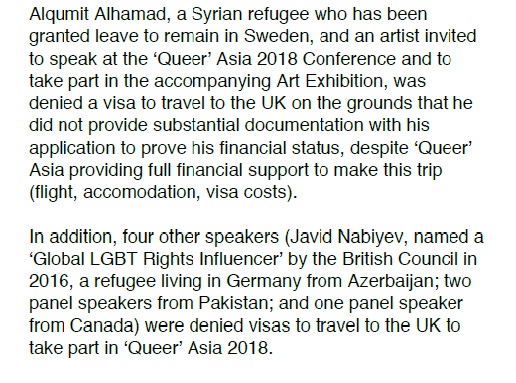QA Blog Series: QA18 Bodies X Borders: Reflections on the conference and film festival
Posted on 17/08/2018
Ping-Hsuan Wang participated in ‘Queer’ Asia Conference 2018.
Film Trailer: Sisak (Dir. Faraz Ansari, 2017).
The shots alternate between two men, with close-ups zooming in on their facial expressions as they exchange eye contact across a Mumbai train, building up the emotional intensity and establishing a subtle tacit connection for the audience to grasp. After several encounters on the train, they become aware of each other’s presence but they always keep their distance. No verbal or physical interaction is initiated; not even when the suited man waits by the door right behind the other man in traditional clothes, or when they stand face to face holding onto a pole to support themselves on the moving train. Emerging is a boundary between them that cannot be crossed. Not a word is uttered. Sisak is an Indian film narrating a love story between two men that is not only unspoken, but one that is unspeakable. The short film ends with a powerful message: homosexuality is a crime in India, dedicating itself to the voiceless romance. Screened at ‘Queer’ Asia 2018 Film Festival (screened at The British Museum), Sisak captivates me in many ways: the cinematic tensions carefully constructed from frame to frame, and the ambience of desire surrounding the two men. Most importantly, it’s a thought-provoking viewing experience for me after I spent three years in Washington, D.C., having gotten used to the LGBTQ advocacy as well as media representation in the U.S.
Coming from Taiwan, where being gay is acceptable as long as you don’t bring it up, I was struck by what I perceived as the “gay agenda” when I first arrived in D.C. in 2015, shortly after the historic Supreme Court ruling that legalized same-sex marriage across the U.S. As a gay migrant, I quickly noticed this difference and came to adopt the idea of being outspoken with respect to one’s queerness, with, for example, newsflash of celebrities coming out on social media. This trend observably reached a peak when two gay-themed Hollywood films caught the public’s attention: Call Me by Your Name (2017) and Love, Simon (2018), celebrating the visibility of gay romance in mainstream productions and speaking to viewers who are taking a firmer stance on the issue of being seen and heard. With a keen introspection of this aspect of queer life, my exploration of being gay in D.C. culminated in my master’s thesis on gay Indian immigrants’ coming-out stories in the U.S. Sisak, in this regard, turned out to be a fateful revisit of the concept pertaining to border-crossing: out of the country, out of the closet.
In my study, I take the theoretical proposal that coming out should be reconceptualized as “describing one’s social location in the changing social context,” (Rust, 1993) to consider how transnational migration can complicate coming out as a personal and impactful process. For my study participants, the changing social context is two-fold: leaving their home country for a foreign destination, and denying the heterosexual assumptions for realizing their gay identity. Sisak, in a similar vein, encourages us to reconceptualize homosexuality as situated in a different social context unlike that in the U.S., using riveting storytelling. It does so exactly through its voicelessness that allows us to engage with same-sex romance in a non-Western society.
For one, it vividly showcases the narrative of being gay in India that I found in interviews. While participants in the U.S. live openly in local communities, their counterparts in India are positioned as succumbing to the societal pressure of arranged marriage while their gay identity remain muted. This quietly echoes the appearance of the wedding rings we see in Sisak on the two men’s fingers that flash from time to time when they move about their hands over the handrails on the train. For another, it challenges my mind that has been primed to expect gay romance dealing with the typical conundrums: family and friends, sexual relations, and accepting oneself. Sisak, by contrast, is less about having a happy or sad ending that we’re used to seeing than about silent and despairing inaction. It can be read as anti-climactic; it’s a rising action that leads to no final resolution under inauspicious circumstances.
To this end, being “India’s first silent LGBTQ story,” Sisak leverages the lack of dialogue, contradictory as it sounds, as the strongest voicing strategy. Voicelessness, contrary to the outspokenness that I have experienced in the U.S., serves to tell a compelling story of gay men’s life in India.
Menstruation by Alqumit Alhamad
Similarly, at the ‘Queer’ Asia Art Exhibition this year, Syrian artist Alqumit Alhamad introduces paintings that are powerfully imaginative. Menstruation, for instance, shows a luna moth resting on a pomegranate branch, on the top of which are a blooming flower and a plump fruit, its side unfolding as labia with ruby-red pulps bursting from within. The surreal juxtaposition of elements in his works viscerally transposes viewers to an eerie spatio-temporal dimension of marginalization as a gay refugee
Image of Alqumit’s art at the Bodies X Borders Art Exhibition
Menstruation, for instance, shows a luna moth resting on a pomegranate branch, on the top of which are a blooming flower and a plump fruit, its side unfolding as labia with ruby-red pulps bursting from within.
However, the artist, along with several other panelists, couldn’t be present at the venue because his application for a visa entering the U.K. was denied. This highlights the political implication of national borders as a social construct that segregates people. Whereas the paintings aim to obscure the divisions of reality to represent the experience of disorientation and displacement, Alquimit’s absence from the exhibition carves a line that accentuates the separation of different social contexts. The action operates on a parallel level of voicelessness in protest of exclusion.
Part of ‘Queer’ Asia’s petition protesting the denial of visas despite full support from the university donors supporting ‘Queer’ Asia. Read more here.
Like the rhythmic rumbling of the night train on which the two Indian men silently ache to break the social boundary, voicelessness as a statement reverberates around the theme this year: body as a site of contestation that brings the very concept of borders into question. While one social context isn’t necessarily more oppressive than another, the imposing borders definitely are. For the third year, artists, scholars, and filmmakers alike gathered at ‘Queer’ Asia, the event continuing to provide a platform for generating ideas that dare us to reflect on, if not imagining the disruption of, the categorical borders through political actions, academic discussions, and artistic expressions.
Works Cited
Rust, Paula C. “‘Coming out’ in the Age of Social Constructionism: Sexual Identity Formation among Lesbian and Bisexual Women.” Gender and Society, vol. 7, no. 1, 1993, pp. 50–77. JSTOR, JSTOR, http://www.jstor.org/stable/190024.
Ping-Hsuan Wang received his M.A. in Language and Communication (MLC), Linguistics, from Georgetown University. His research interests include gay immigrants’ coming-out narratives, framing in family food talk, epistemic positioning in therapeutic discourse, and stance-taking in computer-mediated communication. He tweets @hoganindc2015.
Read More:
Alqumit Alhamad Interview as part of the ‘Queer’ Asia Bodies X Borders blog series



